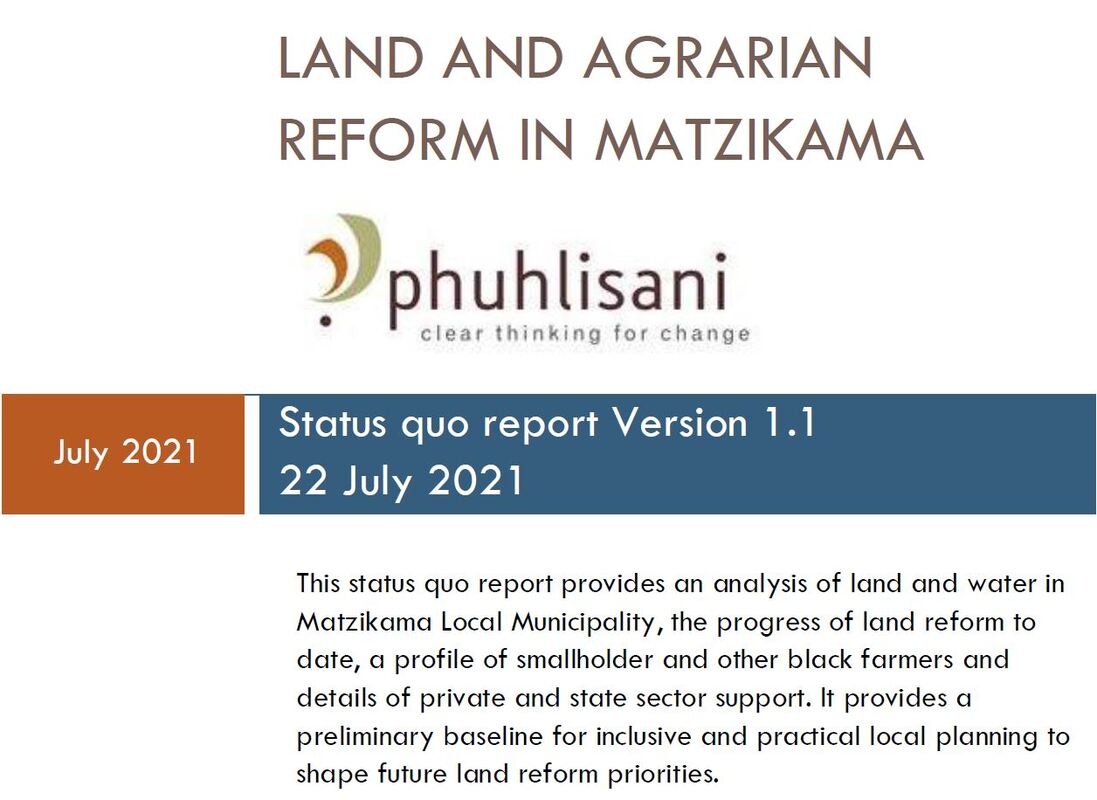Download our SQ reportVersion 1.2 of our status quo report on land and agriculture in Matzikama Local Municipality is now available for download. We have taken steps to anonymise those interviewed to protect personal information and a draft of the report has been been circulated to key actors for approval prior to public release.
As noted in the previous post we still have some significant gaps to fill - particularly information from the National Department of Agriculture, Land Reform and Rural Development which is still outstanding. We will soon publish an updated version of the report which will be augmented by explanatory maps and other data elaborating on commodity value chains, cellars and processors in the Local Municipality.
0 Comments
The status quo report on land and agrarian reform in MatzikamaBreaking a long silence
More than a month has gone past since our last blog entry. And what a challenging time it has been. We have remained hard at work despite the return to Level 4 lockdown, the official announcements of a Covid third wave increasingly fuelled by the Delta variant and the devastating scenes from KwaZulu-Natal and Gauteng over the past couple of weeks which are reported to have claimed over 300 lives. We have just submitted a first draft of an extensive status quo report. This provides:
Phuhlisani NPC gratefully acknowledges all those who have contributed to this initial status quo report. These include the farmers, farmers’ associations, commodity, private sector and civil society organisations, LORWUA, the Matzikama Local Municipality and those officials representing provincial and national government departments, who have contributed their time and knowledge to help create a baseline for inclusive planning for land reform at local municipality scale. We regard the report as a living document as more information is coming in every day from our different research initiatives. We are finalising checks with various stakeholders to authorise the public release of the report which we hope will be available in the next day or so. In the meantime, this post will outline what you can expect from the document and highlight where we are going next. The report covers a lot of ground. It is divided into six sections: Section 1 Section 1 provides a background to the CBPEP research conducted during the first phase of the programme and a brief outline of the objectives of the current project. It also contains a review of the evolving thinking with respect to area-based/territorial planning approaches in government. These include the:
Section 2 provides a detailed overview of land and water in Matzikama. It details a variety of different land types including:
Section 3 Section 3 highlights some of the impacts of drought and Covid 19 on agriculture, employment and livelihoods in the local municipality. This summarises key findings presented in a more in-depth report which is contained in an annexure. Section 4 Section 4 contains rich insights into what is actually happening on the land, as it sets out to profile smallholders and other larger scale black farmers active in the local municipality. This section covers:
Section 5 Section 5 examines different forms of state support to farmers and provides information on land reform budgets and state capacity to provide support. Section 6 Section 6 highlights preliminary findings from a survey instrument seeking to identify current sources of data held by different actors and the extent to which this data can be accessed and shared. Annexures Included in the annexure is a standalone report which provides an analysis of production, processing and marketing trends for the key agricultural commodities produced with the Matzikama municipality. A baseline now in place for planning So the report provides an important baseline for planning. It pools knowledge from different sources. There remain some gaps which we aim to fill over time, but we for we now have something concrete for those contributing to the planning process. Changing the planning sequence The Covid 19 pandemic has forced some changes in our approach. Originally, we had sought to convene a local social platform through a face-to-face meeting. This was to have helped us identify those willing to contribute to core groups focused on different production areas. We are now bypassing this step to put in place working groups which will then report back on their work to a wider convening. We hope to be able to organise the latter as the lockdown restrictions are eased back to Level 3 and we pass beyond the third wave. A meeting in planned for next week to bring together a range of stakeholders, constitute appropriate core groups and clarify their focus and process. More on this in the next couple of days. |
Phuhlisani NPCPlanning Pilot facilitator Archives
June 2022
Categories |

 RSS Feed
RSS Feed
